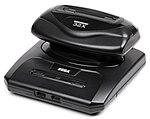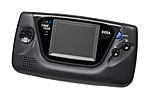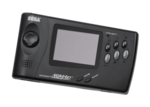世嘉电子游戏机列表

世嘉是电子游戏开发、发行与硬件生产公司,其总部位于日本东京都,并在全球各地设有分公司。公司自1983年起制造家用游戏机和掌上游戏机,所产主机横跨第三世代到第六世代。它是由点唱机生产商日本娱乐物产和街机生产商Rosen Enterprises在1965年合并而成,并在此后20年间继续制作街机游戏。公司在1980年代街机业进入颓势后,转向家用游戏软硬件的开发销售[1]。世嘉首台游戏机是SG-1000,于1983年在日本独占发行。公司此后又在日本发行了多款改良机型,其中第3款主机Sega Mark III于1986年改名Master System于全球销售。公司从1988年开始推出Mega Drive及其外设,1990年推出掌上游戏机Game Gear,1994年推出世嘉土星,1998年推出Dreamcast。
世嘉曾为任天堂在游戏机业的主要竞争者之一。世嘉某些早期主机在部分地区取得优势,如欧洲的Master System。世嘉后期几款主机被视为商业失败,并因Dreamcast财务亏损在2001年内部重组。最终世嘉宣布退出主机制造业,转型第三方游戏开发商[2]。世嘉此后仅在2005年推出教育玩具主机Advanced Pico Beena。部分世嘉原版主机——特别是Master System和Mega Drive——停产后,仍有授权制造商继续生产第三方改良机种。这些机种多由巴西制造,并且仍在销售。
电子游戏机
[编辑]家用游戏机
[编辑]| 游戏机及照片 | 发售时间 | 停产时间 | 世代 |
|---|---|---|---|
| SG-1000 |
|
|
第三世代 |

|
说明: | ||
| SG-1000 II |
|
|
第三世代 |

|
说明: | ||
| Master System | 第三世代 | ||

|
说明: | ||
| Mega Drive | 第四世代 | ||

|
说明:
| ||
| Kids Computer PICO | 第四世代 | ||

|
说明: | ||
| 世嘉土星 | 第五世代 | ||

|
说明: | ||
| Dreamcast |
|
第六世代 | |

|
说明:
| ||
| Advanced PICO Beena |
|
未停产 | 第六世代 |
| 说明: | |||
家用机外设
[编辑]| 游戏机及照片 | 发售时间 | 停产时间 | 世代 |
|---|---|---|---|
| Mega-CD |
|
第四世代 | |

|
说明: | ||
| 32X |
|
第四世代 | |

|
说明: | ||
掌上游戏机
[编辑]| 游戏机及照片 | 发售时间 | 停产时间 | 世代 |
|---|---|---|---|
| Sega Game Gear | 第四世代 | ||

|
说明: | ||
| Sega Nomad |
|
|
第五世代 |

|
说明:
| ||
第三方改版机型
[编辑]世嘉游戏机有经第三方授权或未授权修改。巴西Tectoy修改并发行的Master System 3简版支持射频无线功能。该主机有专门面向女性玩家的Master System Girl版,其外壳为亮粉色。2006年在巴西推出的Master System 3合辑版内置120款游戏[60]。Coleco于2006年在北美发行了掌上版Master System[61]。
Mega Drive是世嘉最早有第三方版本的游戏机:尽管Mega Drive比Master System晚面世3年,但改版却出现的更早。JVS和日本世嘉合作,在1992年4月1日推出了Wondermega,这是Mega Drive和Mega-CD的一体机,音质更高。JVC后又将系统重新设计,于1994年9月以X'Eye名义在北美发行[62]。先锋公司制造的外设模块Pioneer LaserActive可游玩Mega Drive和Mega-CD游戏[63]。Aiwa发行了CSD-GM1,一款植入Mega Drive/Mega-CD单元的Boombox。几间公司也模仿世嘉TeraDrive的设计,在个人电脑中集成了Mega Drive,如科威特和也门的MSX机型AX-330和AX-990,以及在欧洲和澳洲销售的Amstrad Mega PC[4]。Majesco Entertainment在Mega Drive停产后,于1998年北美发行廉价机种Genesis 3[64]。该公司还于1999年8月在北美发行Sega Pico的廉价版[65]。
Mega Drive在在巴西从未中断生产,Tectoy于2007年12月5日发行了Mega Drive携带版,其中内置20款游戏[66]。公司还于2009年发行了“Mega Drive吉他偶像”版,配有两支六键吉他手柄和一个五品键吉他控制器[67]。AtGames 同年开始为北美和欧洲生产两种新Mega Drive机型:Firecore可以插入Mega Drive卡带或游玩预装游戏,掌机版Sega Zone有20款预装Mega Drive游戏[68]。Radica Games等公司推出了像系统控制器那样的“即插即用”游戏合辑[69]。
参考文献
[编辑]- ^ Fahs, Travis. IGN Presents the History of SEGA. IGN. Ziff Davis. 2009-04-21 [2014-09-14]. (原始内容存档于2013-09-10).
- ^ Ahmed, Shahed. Sega announces drastic restructuring. GameSpot. 2001-01-31 [2009-09-20]. (原始内容存档于2010-09-01).
- ^ SG-1000. Sega. [2014-02-14]. (原始内容存档于2014-07-16) (日语).
- ^ 4.0 4.1 4.2 4.3 4.4 4.5 4.6 4.7 McFerran, Damien. Retroinspection: Master System. Retro Gamer (Imagine Publishing): 48–53. ISSN 1742-3155.
- ^ Battelle, John. The Next Level: Sega's Plans for World Domination. Wired (Condé Nast). December 1993 [2013-10-09]. (原始内容存档于2012-05-02).
- ^ SC-3000. Sega. [2013-02-15]. (原始内容存档于2014-07-16) (日语).
- ^ Kohler, Chris. Playing the SG-1000, Sega's First Game Machine. Wired. Condé Nast. 2009-10-02 [2009-10-05]. (原始内容存档于2014-01-01).
- ^ SC-3000H. Sega. [2013-02-15]. (原始内容存档于2014-02-22) (日语).
- ^ Mark III. Sega. [2014-03-31]. (原始内容存档于2014-07-16) (日语).
- ^ 10.0 10.1 10.2 10.3 Beuscher, David. Sega Master System - Overview. Allgame. All Media Network. [2014-03-31]. (原始内容存档于2014-09-14).
- ^ Cowen, Danny. Sega Master System Launch Schedule Reveals Unreleased Hot Rod, Phantasy Star II. GameSetWatch. UBM. 2011-09-14 [2014-06-22]. (原始内容存档于2014-09-14).
- ^ Sheff, David. Game Over 1st. Random House. 1993: 349. ISBN 0-679-40469-4.
- ^ Slaven, Andy. Video Game Bible: 1985-2002. Trafford Publishing. 2002-06-30: 225. ISBN 1-553-69731-6.
In Europe, Sega continued production of the Master System until 1996.
- ^ Azevedo, Théo. Vinte anos depois, Master System e Mega Drive vendem 150 mil unidades por ano no Brasil. Universo Online. Grupo Folha. 2012-07-30 [2012-08-06]. (原始内容存档于2014-09-06) (葡萄牙语).
- ^ 15.0 15.1 15.2 Retroinspection: Mega Drive. Retro Gamer (Imagine Publishing). 2006, (27): 42–47. ISSN 1742-3155.
- ^ Kent, Steven L. The Ultimate History of Video Games: The Story Behind the Craze that Touched our Lives and Changed the World. Prima Publishing. 2001: 404–405. ISBN 0-7615-3643-4.
- ^ Sega tops holiday, yearly sales projections; Sega Saturn installed base reaches 1.6 million in U.S., 7 million worldwide. Business Wire. Berkshire Hathaway. 1997-01-13 [2013-10-13]. (原始内容存档于2013-04-11).
- ^ Sega farms out Genesis. Consumer Electronics. Warren Communications News. 1998-03-02 [2012-07-09]. (原始内容存档于2012-07-09).
- ^ Sega Service Manual (Supplement): Genesis II/Mega Drive II. Sega. 1993.
- ^ Marriott, Scott Alan. Sega Genesis Nomad - Overview. Allgame. All Media Network. [2013-10-05]. (原始内容存档于2014-09-14).
- ^ Redsell, Adam. SEGA: A Soothsayer of the Game Industry. IGN. Ziff Davis. 2012-05-20 [2013-10-05]. (原始内容存档于2013-10-12).
- ^ Cartridge Console With 15 Sega Megadrive Games. Blaze Europe. [2010-07-16]. (原始内容存档于2014-08-04).
- ^ Kent, Steven L. The Ultimate History of Video Games: The Story Behind the Craze that Touched our Lives and Changed the World. Prima Publishing. 2001: 447. ISBN 0-7615-3643-4.
- ^ Clements, Matthew T.; Ohashi, Hiroshi. Indirect Network Effects and the Product Cycle: Video Games in the U.S., 1994–2002 (PDF). NET Institute: 12, 24. October 2004 [2011-09-21]. (原始内容存档 (PDF)于2014-09-14).
- ^ ファミ通エクスプレス "ピコ"といっても紅茶じゃないぞッ! セガが幼児向けコンピューターを発売. Famicom Tsūshin (ASCII Media Works). 1993-06-11, 8 (24): 11 (日语).
- ^ 26.0 26.1 Sega captures dollar share of videogame market -- again; diverse product strategy yields market growth; Sega charts path for 1996.. Business Wire. Berkshire Hathaway. 1996-01-10 [2011-09-29]. (原始内容存档于2014-05-02).
- ^ 27.0 27.1 TOSEC: Sega Pico. Internet Archive. 2012-04-13 [2014-06-22]. (原始内容存档于2014-01-23).
- ^ 28.0 28.1 28.2 28.3 食育、安全などの“五育”を取り入れ、エデュテイメント事業を推進「遊びながら学ぶ」が進化する『Advanced PICO BeenaTM』(アドバンスピコ ビーナTM)8月発売 (PDF). Sega. 2005-04-05 [2014-06-03]. (原始内容 (PDF)存档于2007-09-28) (日语).
- ^ Edison, N.J.-Based Firm Signs Video Game Distribution Deal with Sega.. Home News Tribune – 通过HighBeam Research
 . Gannett Company. 1999-08-06 [2011-09-29]. (原始内容存档于2014-06-29).
. Gannett Company. 1999-08-06 [2011-09-29]. (原始内容存档于2014-06-29).
- ^ 30.0 30.1 Beuscher, David. Sega Pico - Overview. Allgame. All Media Network. [2014-06-03]. (原始内容存档于2014-09-14).
- ^ Sega Toys Business Strategy. Sega. 2005 [2016-01-08]. (原始内容存档于2005-12-16).
- ^ Sega Saturn. Sega. [2014-03-03]. (原始内容存档于2014-07-16) (日语).
- ^ Cifaldi, Frank. This Day in History: Sega Announces Surprise Saturn Launch. 1UP.com. Ziff Davis. 2010-05-11 [2014-05-04]. (原始内容存档于2014-09-14).
- ^ 34.0 34.1 McFerran, Damien. Retroinspection: Sega Saturn. Retro Gamer (Imagine Publishing): 44–49. ISSN 1742-3155.
- ^ 35.0 35.1 Kent, Steven L. The Ultimate History of Video Games: The Story Behind the Craze that Touched our Lives and Changed the World. Prima Publishing. 2001: 558–559. ISBN 0-7615-3643-4.
- ^ Moriarty, Colin. Sega Pluto: The console that never was?. IGN. Ziff Davis. 2013-04-18 [2014-03-03]. (原始内容存档于2014-03-20).
- ^ Lefton, Terry. Looking for a Sonic Boom. Brandweek (Nielsen Business Media). 1998, (39.9): 26–29. ISSN 1064-4318.
- ^ Hernandez, Patricia. Happy 15th Birthday, Dreamcast!. Kotaku. Gawker Media. 2013-11-28 [2014-06-13]. (原始内容存档于2014-03-29).
- ^ 39.0 39.1 Dreamcast beats Playstation record. BBC News. 1999-11-24 [2008-08-19]. (原始内容存档于2013-10-16).
- ^ Sega Scraps the Dreamcast. BBC News. 2001-02-24 [2008-08-22]. (原始内容存档于2014-08-13).
- ^ Sega Sports NFL 2K1 Outsells the Competition on Its Debut; First Ever Online Console Game NFL 2K1 Becomes Number One Football Game This Fall. Business Wire (Berkshire Hathaway). 2000-11-28 [2008-08-19]. (原始内容存档于2014-09-14).
- ^ Wilde, Tyler. A tribute to the Dreamcast VMU. GamesRadar. Future. 2009-09-08 [2014-06-13]. (原始内容存档于2014-09-14).
- ^ Sega warns of losses. BBC News. 2000-02-28 [2014-06-13]. (原始内容存档于2013-11-11).
- ^ 『BeenaLite(ビーナライト)』7月17日新発売 (PDF). Sega. 2008-06-18 [2014-10-23]. (原始内容存档 (PDF)于2014-08-16) (日语).
- ^ Mega-CD. Sega. [2014-03-29]. (原始内容存档于2014-07-16) (日语).
- ^ Kent, Steven L. The War. The Ultimate History of Video Games: The Story Behind the Craze that Touched our Lives and Changed the World. Prima Publishing. 2001. ISBN 0-7615-3643-4.
- ^ 47.0 47.1 Birch, Aaron. Next Level Gaming: Sega Mega-CD. Retro Gamer (Live Publishing). 2005, (17): 36–42. ISSN 1742-3155.
- ^ Beuscher, David. Sega CD - Overview. Allgame. All Media Network. [2013-06-27]. (原始内容存档于2014-09-14).
- ^ Mega-CD 2. Sega. [2014-03-29]. (原始内容存档于2014-05-30) (日语).
- ^ Marriott, Scott Alan. Sega Genesis CDX - Overview. Allgame. All Media Network. [2013-06-27]. (原始内容存档于2014-09-14).
- ^ Videospiel-Algebra. Cybermedia Verlagsgesellschaft. May 1995 (德语).
|journal=被忽略 (帮助) - ^ Super 32X. Sega. [2014-02-23]. (原始内容存档于2014-07-16).
- ^ 53.0 53.1 Kent, Steven L. The "Next" Generation (Part 1). The Ultimate History of Video Games: The Story Behind the Craze that Touched our Lives and Changed the World. Prima Publishing. 2001. ISBN 0-7615-3643-4.
- ^ McFerran, Damien. Retroinspection: Sega 32X. Retro Gamer (Imagine Publishing): 44–49. ISSN 1742-3155.
- ^ 55.0 55.1 55.2 55.3 Beuscher, David. Sega Genesis 32X — Overview. Allgame. All Media Network. [2013-06-07]. (原始内容存档于2014-09-14).
- ^ Forster, Winnie. The Encyclopedia of Game.Machines: Consoles, Handhelds, and Home Computers 1972-2005. Magdalena Gniatczynska. 2005: 139. ISBN 3-0001-5359-4.
- ^ Retroinspection: Sega Game Gear. Retro Gamer (Imagine Publishing). 2009, (41): 78–85. ISSN 1742-3155.
- ^ 58.0 58.1 Sega Game Gear. Retro Gamer (Live Publishing). 2005, (17): 26–35. ISSN 1742-3155.
- ^ 59.0 59.1 59.2 Beuscher, David. Sega Game Gear - Overview. Allgame. All Media Network. [2013-07-08]. (原始内容存档于2014-09-14).
- ^ Szczepaniak, John. Company Profile: Tec Toy. Retro Gamer (Imagine Publishing). 2006, (30): 50–53. ISSN 1742-3155.
- ^ Ransom-Wiley, James. Sega-filled handheld. Joystiq. AOL. 2006-10-26 [2010-04-22]. (原始内容存档于2014-04-07).
- ^ Marriott, Scott Alan. JVC X'Eye - Overview. Allgame. All Media Network. [2013-07-02]. (原始内容存档于2014-09-14).
- ^ Marriott, Scott Alan. Pioneer LaserActive - Overview. Allgame. All Media Network. [2013-07-02]. (原始内容存档于2014-09-14).
- ^ Sheffield, Brandon. A Casual Rebirth: The Remaking of Majesco. Gamasutra. UBM. 2009-08-10 [2013-10-09]. (原始内容存档于2014-05-10).
- ^ Edison, N.J.-Based Firm Signs Video Game Distribution Deal with Sega.. Home News Tribune. Gannett Company. 1999-08-06 [2011-09-29]. (原始内容存档于2014-06-29) –通过HighBeam Research
 .
.
- ^ Melanson, Donald. Brazil's TecToy cranks out Mega Drive portable handheld. Engadget. AOL. 2007-11-13 [2007-01-23]. (原始内容存档于2013-10-12).
- ^ Mega Drive Guitar Idol - 87 jogos. Tectoy. [2010-07-16]. (原始内容存档于2009-08-26) (葡萄牙语).
- ^ Innex Launches Products Containing Licensed Sega Genesis Titles In Time For Q4 Holiday Season. Innex. September 2009 [2011-04-25]. (原始内容存档于2014-07-22).
- ^ Horowitz, Ken. Hands-On: Arcade Legends (Plug-'n-Play). Sega-16. 2004-09-16 [2013-11-17]. (原始内容存档于2014-07-02).

